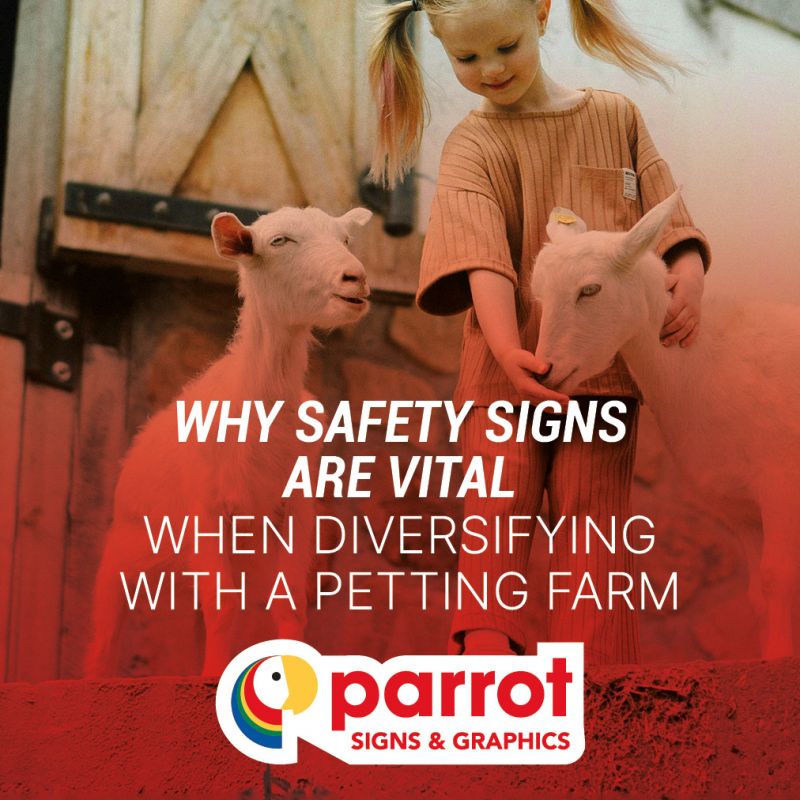Why Safety Signs Are Vital When Diversifying with a Petting Farm
Mon 23rd June 2025Setting up a petting farm is a popular and rewarding way for farmers to diversify, offering families a chance to engage with animals and enjoy rural life. But before inviting the public onto your land, there’s one essential element that should never be overlooked: safety signage.
Safety signs play a crucial role on any petting farm. They’re not just helpful, they’re a legal requirement and a practical necessity. Proper signage communicates vital health and safety information to your visitors, helping to prevent accidents, promote hygiene, and manage expectations. From instructing guests to wash their hands after touching animals, to alerting them to low fencing, slippery paths, or emergency exits, signs help keep everyone safe. They also provide reassurance that the farm is professionally run and well thought out.
In addition to health and safety signs, clear directional signage helps families easily navigate the site. Wayfinding signs for toilets, picnic areas, handwashing stations and animal enclosures help to create a smooth and enjoyable experience for all ages. Good signage contributes directly to visitor satisfaction and repeat custom.
Once signage is in place, there are several other important considerations when launching a petting farm. Here are five key areas to focus on:
1. Licences, Insurance, and Promotion
Before opening to the public, it’s vital to ensure that your petting farm meets all legal and regulatory requirements. Depending on the size and setup, you may need planning permission, a zoo licence (if you have exotic species), or other local authority permissions. Speak to your local council early in the planning stages.
Public liability insurance is essential, covering injuries, illness, or damage that could occur during a visit. If you’ll be hosting school trips or parties, check that your policy covers group bookings and educational activities.
On the marketing side, building a simple, professional website and active social media presence can help attract families and community groups. Promoting seasonal events such as Easter lamb feeding or Halloween pumpkin trails can also encourage repeat visits.
2. Risk Assessment and Hygiene
A thorough risk assessment helps identify hazards and put controls in place to keep visitors safe. This includes physical risks such as uneven ground or water troughs, as well as potential risks from animals. You should review and update your assessment regularly, particularly if new activities or animals are introduced.
Hygiene is another critical consideration. Farms must provide proper handwashing facilities with running water, soap and paper towels. These should be located near all animal contact areas and at key points across the site. Robust cleaning schedules and clear visitor instructions should also be part of your routine operations.
- Take a look: Now wash your hands sign
- Take a look: Uneven ground sign
3. Choosing the Right Animals
The animals you choose should be friendly, manageable, and well-suited to close contact with children. Goats, sheep, ponies, rabbits and chickens are all popular choices, but they must be healthy, well-socialised and kept in clean, comfortable enclosures.
Under the Animal Welfare Act 2006, you’re legally responsible for meeting your animals’ needs, including access to fresh water, suitable food, shelter, and veterinary care. You’ll also need to monitor how animals interact with visitors and rotate them out of contact areas when needed to prevent stress.
4. Family-Friendly Facilities
A successful petting farm caters to the needs of parents as much as children. Visitors will expect clean toilets, baby-changing areas, accessible paths, seating areas, and perhaps a picnic spot or refreshments. Making the site pram- and wheelchair-friendly will also widen your appeal.
Clear, family-friendly facilities help encourage longer stays and good reviews. Even small touches such as somewhere dry to store bags or designated animal feeding areas can make a big difference to how guests experience your farm.
- Take a look: toilet signs
- Take a look: baby change sign
5. Staffing and Training
Behind every successful petting farm is a knowledgeable and friendly team. Whether they’re family members, seasonal staff, or volunteers, your team should be well-trained in customer service, basic first aid, animal handling and health and safety procedures.
Staff also help monitor interactions, spot potential issues early, and answer visitor questions. Briefings at the start of each day, clear emergency procedures, and well-communicated roles all contribute to smooth, safe operations.
Conclusion
Diversifying with a children’s petting farm can be a brilliant way to generate new income while sharing your love of animals with the public. But it’s not as simple as opening the gates and letting people in. Farmers must consider safety, signage, animal welfare, facilities, and legal compliance in equal measure.
From clear hygiene reminders to well-placed directional signs, signage plays a central role in creating a safe, welcoming, and family-friendly experience. It’s one of the simplest and most important investments you can make in your diversification journey.
